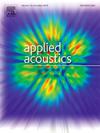Slow waves in ducts with external SBH insertion and perforated boundaries
IF 3.4
2区 物理与天体物理
Q1 ACOUSTICS
引用次数: 0
Abstract
An acoustic duct with external sonic black hole (E-SBH) insertion differs from the widely studied conventional configuration in which SBH components are located inside the duct. The E-SBH has the foreseeable benefit of avoiding flow obstruction inside the conduit while preserving the desired SBH effects. The characterizations of such SBH configurations alongside the wave propagation properties along the duct, however, have been less investigated. In this study, we analyze an E-SBH with perforation-modulated boundaries by means of theoretical, numerical and experimental methods. Wentzel-Kramers-Brillouin (WKB) solutions and their applicable ranges are first developed, allowing for a comprehensive characterization of slow-wave phenomena in both bare E-SBH and perforation-modulated E-SBH (PME-SBH) configurations. These solutions, verified against numerical simulations, provide a complete and analytical description of wave speed variations and define theoretical slow-wave limits for a given set of system parameters. By incorporating perforated boundaries and optimizing the perforation parameters, PME-SBH is shown to entail enhanced wave retarding effect, maintaining slow-sound with fewer inner rings. Finally, time-domain experiments confirm the predicted slow-wave effects in both external SBH configurations.
有外部SBH插入和穿孔边界的管道中的慢波
具有外部声波黑洞(E-SBH)插入的声学管道不同于广泛研究的传统结构,其中SBH组件位于管道内。E-SBH具有可预见的优点,可以避免管道内的流动阻塞,同时保持所需的SBH效果。然而,这种SBH结构的特征以及沿管道的波传播特性的研究较少。在本研究中,我们通过理论、数值和实验方法分析了具有射孔调制边界的E-SBH。Wentzel-Kramers-Brillouin (WKB)解决方案及其适用范围首次被开发出来,可以全面表征裸E-SBH和射孔调制E-SBH (PME-SBH)配置中的慢波现象。这些解决方案,通过数值模拟验证,提供了波速变化的完整和分析描述,并定义了给定一组系统参数的理论慢波极限。通过结合射孔边界和优化射孔参数,PME-SBH具有增强的波缓速效果,能够以更少的内环保持慢声。最后,时域实验证实了预测的两种外部SBH构型的慢波效应。
本文章由计算机程序翻译,如有差异,请以英文原文为准。
求助全文
约1分钟内获得全文
求助全文
来源期刊

Applied Acoustics
物理-声学
CiteScore
7.40
自引率
11.80%
发文量
618
审稿时长
7.5 months
期刊介绍:
Since its launch in 1968, Applied Acoustics has been publishing high quality research papers providing state-of-the-art coverage of research findings for engineers and scientists involved in applications of acoustics in the widest sense.
Applied Acoustics looks not only at recent developments in the understanding of acoustics but also at ways of exploiting that understanding. The Journal aims to encourage the exchange of practical experience through publication and in so doing creates a fund of technological information that can be used for solving related problems. The presentation of information in graphical or tabular form is especially encouraged. If a report of a mathematical development is a necessary part of a paper it is important to ensure that it is there only as an integral part of a practical solution to a problem and is supported by data. Applied Acoustics encourages the exchange of practical experience in the following ways: • Complete Papers • Short Technical Notes • Review Articles; and thereby provides a wealth of technological information that can be used to solve related problems.
Manuscripts that address all fields of applications of acoustics ranging from medicine and NDT to the environment and buildings are welcome.
 求助内容:
求助内容: 应助结果提醒方式:
应助结果提醒方式:


